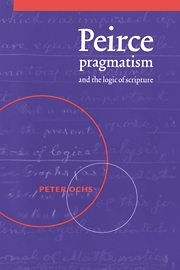Book contents
- Frontmatter
- Contents
- List of abbreviations
- PART I Peirce's pragmatic writing
- 1 Introduction: reading Peirce's pragmatism
- 2 Pragmatic methods of reading and interpretation
- 3 Problems in Peirce's early critique of Cartesianism
- 4 Problems in Peirce's early theory of pragmatism
- 5 Problems in Peirce's normative theory of pragmatism, 1878–1903
- 6 A pragmatic reading of Peirce's lectures on pragmatism
- PART II Peirce's pragmaticist writing
- Notes
- Index
5 - Problems in Peirce's normative theory of pragmatism, 1878–1903
Published online by Cambridge University Press: 22 October 2009
- Frontmatter
- Contents
- List of abbreviations
- PART I Peirce's pragmatic writing
- 1 Introduction: reading Peirce's pragmatism
- 2 Pragmatic methods of reading and interpretation
- 3 Problems in Peirce's early critique of Cartesianism
- 4 Problems in Peirce's early theory of pragmatism
- 5 Problems in Peirce's normative theory of pragmatism, 1878–1903
- 6 A pragmatic reading of Peirce's lectures on pragmatism
- PART II Peirce's pragmaticist writing
- Notes
- Index
Summary
Fisch reports that:
in the best draft of the fourth Monist paper [of 1905] Peirce wrote that he had “passed through a doubt of pragmatism lasting very nearly twenty years … The “principal positive error” of the original exposition, Peirce later said, was its nominalism [8.216]. … He remained a nominalist in that sense until late in 1896, when he repudiated the “nominalist view of possibility, and explicitly” returned “to the Aristotelian doctrine of a real possibility. This was the great step that was neeed to render pragmaticism an intelligible doctrine.” (5.526–32)
Expanding Peirce's actual claim, I bracket the roughly twenty-five years from the publication of his 1878 “Illustrations” to the publication of his 1903 Lectures on Pragmatism as the period of his “Normative Theory of Pragmatism.” Collected together, Peirce's philosophic writings during this period display an attempt to strain from his philosophic inquiries a single Norm of Conduct with respect to which he could repair the uncertainties and confusions that plagued his understanding of pragmatism. To make sense out of the tensions and strains in these writings, I attribute to them a version of the antinomy of realist and conceptualist tendencies that I attributed to his 1877–8 writings. This time, however, the dialectic is more complex, since Peirce gradually criticizes the antinomy and seeks to ferret out and repair its source in his own “nominalism.” I therefore portray Peirce's writings as divided not only between the two antinomic tendencies but also among a second set of three conflicting tendencies.
- Type
- Chapter
- Information
- Peirce, Pragmatism, and the Logic of Scripture , pp. 104 - 127Publisher: Cambridge University PressPrint publication year: 1998



